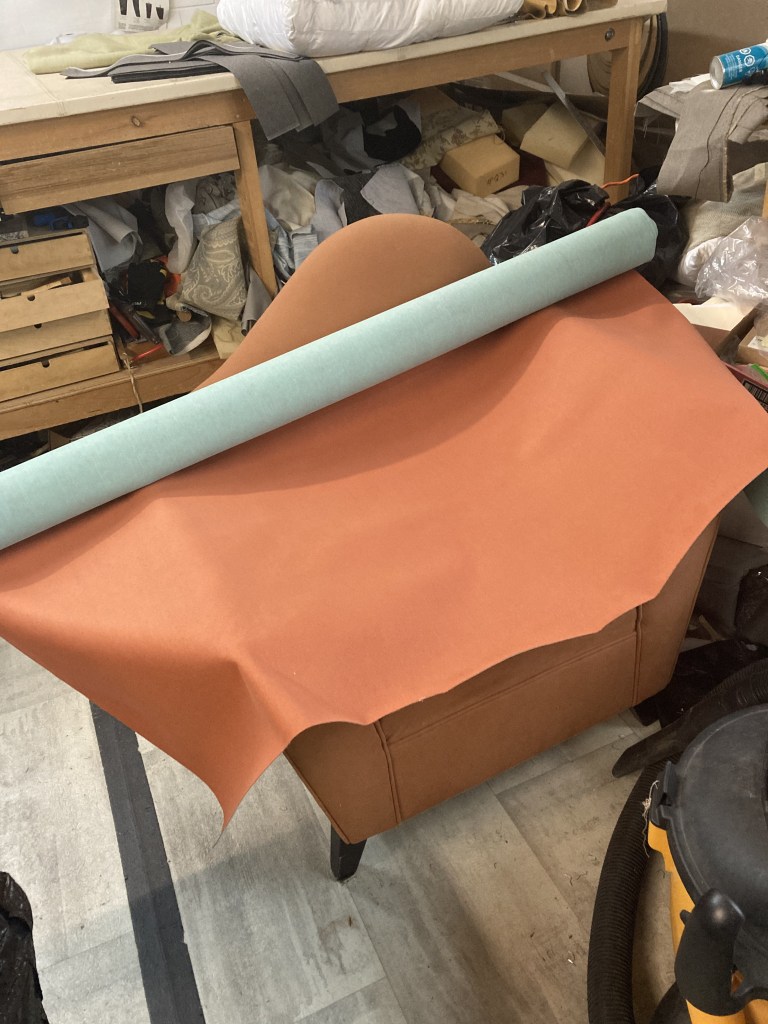First, you reduce the amount of stuff through donation or sale.
Next, you decide what of your current stuff you can reuse in your new space.
And finally, you look at what’s left and figure out, is there any way to give this stuff a tszuj, as Carson Kreeley from the original Queer Eye makeover show would put it.
It should not surprise any faithful reader of this blog series Renovation Road that my TV junk food is makeover shows. Clean Sweep (Keep, Sell, and Toss, anyone?) Queer Eye, both incarnations. What Not To Wear. Not a fan of ones involving surgery or ridiculous diet-and-exercise boot camps. I prefer when the magic happens by choosing just the right fabric or outfit: a little more of this; a little less of that.
Makeover shows often feature ingenious repurposing of old furnishings, or old wardrobe pieces. We aren’t doing anything in this renovation that will earn us a spot in the Recycling Hall of Fame. There are no light fixtures made from wastepaper baskets or a leaky canoe made into a feature bookshelf. But we are refreshing several items that means we’re sending less to landfill, even if in some cases it’s costing us pretty much the same as it would to toss out the old and buy new.
On the bargain end of things is refreshing a few cast iron pieces: it’s a wonder what a couple cans of for-metal spray paint can do for a dingy, rusty piece. We now have a hall bench, magazine rack and a little garden table all in a fresh, crisp white.
When first furnishing our house for rental, we found a treasure trove of inexpensive teak furniture that’s being restored through patient cleaning and oiling treatment, with the dining room chairs getting fresh upholstery.
The big investment is recycling our living room furniture: A Danish L-shaped couch and accompanying chair that have already seen more than a couple decades of service.
At first, we thought the couch seating cushions just needed new fabric but the living room in our Toronto apartment did not get direct sunlight. Once we moved the couch out into bright sun on moving day, we realized the whole piece had become dingy and could use a refresh. Same with the chair.
The upholsterer I knew best in Stratford, who ran a company named Spitalfields, had retired so I asked around for recommendations. One lead ran cold when schedules didn’t mesh. Then a few people suggested calling Michael Comrie, known as That Guy’s Upholstery.
A side note about things such as upholstery, sewing, woodworking and all manner of craft. Stratford is a small place: while legally a city, the population is only 32,000. But we have a disproportionate number of highly skilled craftspeople among us, with some of that driven by the fact the Stratford Festival, the largest non-profit performing arts organization in Canada, employs designers, sewers, tailors, jewellery makers, metal workers, carpenters and more to create stage magic. There are people who know how to make metal armour, hand-knot real-hair wigs, create shoes that were in fashion in 1350 and fashion huge feast tables where all the delicious-looking food is made from styrofoam, paper and paint.
My retired upholsterer came to Stratford originally to work at the theatre and then set up shop on her own. It took me awhile to discover Michael had, in fact, worked for her and had fixed the very same L shaped couch we were now redoing when it needed repair after the wear-and-tear of beloved puppy paws had roughened the seat fabric. “I have all the files from Spitalfields here somewhere”, Michael said, “so somewhere I already have that couch’s measurements!” But the “here” he’s referring to is a crowded, higgledy-piggledy workshop around the back of an auto parts store, and he never did find the original files. He did his measurements once the furniture moved to a Stratford storage locker.

Once again, as with wallpaper, paint and so much else in the world of décor, you don’t realize the enormity of choice that’s out there when it comes to fabric until you’re in the position of deciding what to use for a reupholstery project. I learned about Wyzenbeeker and Martindale ratings, measuring durability. I learned that fabrics within the same swatch book, which looked similar, could vary wildly in price. And I learned that just because you fall in love with a fabric from a sample catalogue doesn’t mean it is available to order, any more.
We eventually found a set of complementary fabrics for the sofa and chair that were a) in our budget b) durable and c) available. Once this reupholstery is finished — including accent pillows made from the fabric that inspired our colour palette for this renovation — we’ll put sofa and chair in place in the new living room and then figure out what other small furnishings we could add to provide more seating space when we have a group over for a party or dinner.
And if the longevity gods are kind, perhaps we’ll do one more round of recycling reupholstery, a couple decades from now.
Hello Kelley,
I am really enjoying your reno blog and find myself looking at my email more frequently to see if you have posted a new update. I also walk past your place at least once if not twice a day as I live on Cobourg St. Hopefully I’ll run into this spring! Cheers and good luck on the final leg of your revovation journey. Joan
LikeLike
Loving this series! Especially this latest report that includes my dear college mate Michael Comrie- such a lovely human and deeply talented. I know he won’t disappoint.
LikeLike